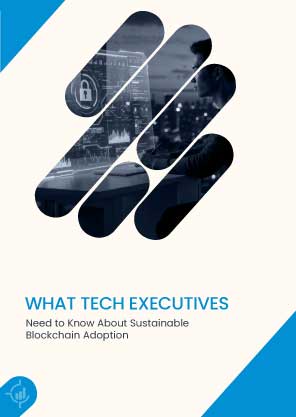or call: +1 (845) 347-8894

or call: +1 (845) 347-8894

Blockchain is no longer the shiny new experiment sitting on the edge of innovation. It has quietly moved into the enterprise stack. Yet as adoption accelerates, one question keeps resurfacing in boardrooms: Can blockchain scale responsibly? For many technology leaders, sustainable blockchain adoption is no longer optional. It’s a strategic imperative tied to compliance, ESG expectations, and long-term operational efficiency.
The conversation has matured. Blockchain is now less about hype and more about measurable value. But making it sustainable requires the right mix of architecture, governance, and realistic business thinking. Here’s what executives should understand as they build blockchain strategies for 2026 and beyond.
A few years ago, blockchain raised concerns for its energy footprint, especially with early proof-of-work systems. Today, that narrative is changing. The global blockchain technology market size is projected to grow from US $20.16 billion in 2024 to US $31.18 billion in 2025, according to a 2025 market report. The shift is happening because executives are feeling new pressure from regulators, investors, and customers to reduce digital carbon footprints.
Sustainable blockchain adoption is no longer just a technical question. It’s tied to ESG reporting, stakeholder transparency, and corporate risk management. If your organization is experimenting with blockchain pilots that don’t align with energy efficiency goals, the incompatibility will be obvious when your ESG team audits system impact.
Not all blockchains operate the same way. Modern enterprise platforms have evolved far beyond their early predecessors. Proof-of-stake, Byzantine fault tolerance, and hybrid consensus models significantly reduce energy consumption while enabling the scalability needed for real-world workloads.
For technology leaders, the takeaway is straightforward: sustainable blockchain adoption depends heavily on the consensus mechanism you standardize on. When evaluating solutions, ask:
Executives who ask these questions early avoid expensive redesigns later.
Public blockchains still grab headlines, but behind the scenes, enterprises are quietly choosing private and permissioned networks. These architectures offer lower energy use, faster transaction speeds, and far more control over governance and compliance.
A recent 2025 industry survey shows that nearly 70 percent of enterprise blockchain projects now prefer permissioned frameworks due to sustainability and cost advantages. These systems also integrate more easily with existing cloud infrastructure, enabling organizations to optimize workloads based on real-time energy availability.
For companies already committed to decarbonization pathways, permissioned architectures make sustainable blockchain adoption a realistic goal rather than a marketing promise.
There’s a misconception that sustainability is only about energy use. In reality, sustainable blockchain adoption requires thinking about operational sustainability as well. Systems must be resilient, interoperable, and maintainable – especially in environments where blockchain supports mission-critical workflows.
Executives should ensure that any blockchain deployment:
These operational efficiencies not only lower energy use but also reduce long-term costs. Sustainable infrastructure is efficient infrastructure.
Tokenization is emerging as one of the most promising enterprise applications, and it aligns naturally with sustainable blockchain adoption. Whether it’s supply chain assets, carbon credits, identity credentials, or real-world financial products, tokenization reduces friction, improves traceability, and helps organizations automate complex workflows.
In 2025, the World Economic Forum emphasized that tokenized asset ecosystems could reduce operational costs by as much as 30 percent for industries that rely heavily on manual verification. Those efficiencies compound when combined with energy-efficient blockchain models. The key for executives is identifying use cases where tokenization improves both business value and carbon alignment.
Even the most energy-efficient blockchain fails if governance is weak. Sustainable blockchain adoption requires robust governance frameworks that define who operates nodes, how data is shared, and which stakeholders control access. Without well-designed policies, organizations risk spiraling energy use, shadow IT deployments, and unnecessary redundancy.
C-suite leaders should work with CIOs, CISOs, and legal teams to create governance models that align blockchain operations with sustainability and compliance goals.
Sustainable blockchain adoption is about more than technical optimization. It represents a strategic shift toward responsible innovation, where performance, energy efficiency, and long-term value go hand in hand. For technology executives shaping future digital ecosystems, the winners will be the organizations that scale blockchain with intention—not just speed.
The opportunity is clear. Blockchain can be both powerful and sustainable. The organizations that understand this early will set the standard for the next era of enterprise technology.
1. What is sustainable blockchain adoption?
Sustainable blockchain adoption refers to deploying blockchain solutions in a way that minimizes energy consumption, reduces operational waste, and aligns with enterprise ESG and compliance goals. It includes choosing energy-efficient consensus models, optimizing governance, and ensuring long-term scalability.
2. Why should tech executives care about sustainability in blockchain?
Sustainability impacts regulatory compliance, ESG reporting, energy costs, and brand reputation. Enterprises adopting blockchain without sustainability measures risk higher costs, inefficient architectures, and negative ESG scores.
3. Which blockchain models are most sustainable for enterprise use?
Permissioned and private blockchains using consensus mechanisms like Proof of Stake or Byzantine Fault Tolerance offer far lower energy consumption and higher throughput, making them ideal for sustainable blockchain adoption.
4. Does sustainable blockchain adoption reduce operational costs?
Yes. Efficient consensus mechanisms, streamlined smart contract automation, and reduced manual auditing can significantly lower energy use and long-term operating expenses.
5. How does tokenization support sustainability goals?
Tokenization improves traceability, reduces paper-based workflows, and automates verification processes. This lowers resource consumption and supports green-data strategies across supply chains and financial systems.
To participate in our interviews, please write to our IntentTech Media Room at info@intentamplify.com




